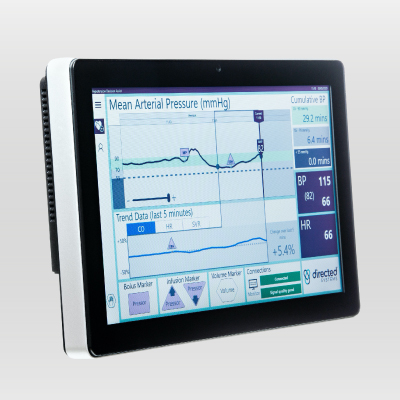New clinical software set to assist anaesthetists during high-risk surgery
Cambridge Design Partnership plays a key role in a pioneering product aimed at helping to better manage intra-operative hypotension and the associated complications that occur during surgery
Cambridge Design Partnership (CDP) has worked with British medical device company Directed Systems to develop a new clinical decision support software solution for clinicians in the operating room.
The software allows anaesthetists to view and analyse hypotensive relevant vital signs data from the patient throughout an operation and will highlight anomalies. Currently, anaesthesia patient monitoring solutions are focused on the current situation and, while they display trends and alarm thresholds, do not offer the sophisticated analysis related to hypotensive episodes and overall durations of hypotension during surgery, so HDA is a useful adjunct to these systems.
The new software has achieved FDA 510(k) clearance for sale in the USA.
“We are delighted to see this important product come to fruition, It was very rewarding for our team to have played such a key role in developing this exciting technology.” said Head of Medical Therapy at Cambridge Design Partnership.
Low blood pressure (hypotension) during surgery occurs frequently and there is substantial evidence that patients undergoing major or emergency surgery do not tolerate this for even short periods. While anaesthetists are skilled at controlling blood pressure surgeries can be lengthy and constant vigilance difficult. Research shows that reducing hypotension can reduce, occurrence of post-operative complications resulting in long term health problems, minimise hospital stays, improve patient outcomes and reduce healthcare costs1.
Directed Systems approached CDP to help them turn their decision support concept into reality. “We first helped identify the optimum product development strategy”, explains Karl Hewson, Senior Human Factors Engineer at CDP. “Extensive discussions with healthcare stakeholders identified that the first product should provide an at-a-glance view to the anaesthetist of the overall state of their patient’s hypotensive situation, to help them make more informed decisions and to better manage hypotension while on the operating table”
Using this research data, CDP then developed the software user interface (UI). “We started with the various therapy protocols that were used, and we created an information hierarchy and workflow that would support and enhance the decision-making process,” said Karl.

“We are all very pleased with the project outcome and look forward to seeing Hypotension Decision Assist (HDA)TM in commercial use, we are also looking forward to helping to develop the technology further in the future,”
For further information and media enquiries, please contact: hello@cambridge-design.com or call 01223 264428
1 – Keuffel, E. L., Rizzo, J., Stevens, M., Gunnarsson, C., & Maheshwari, K. (2019). Hospital costs associated with intraoperative hypotension among non-cardiac surgical patients in the US: a simulation model. Journal of Medical Economics, 22(7), 645–651.